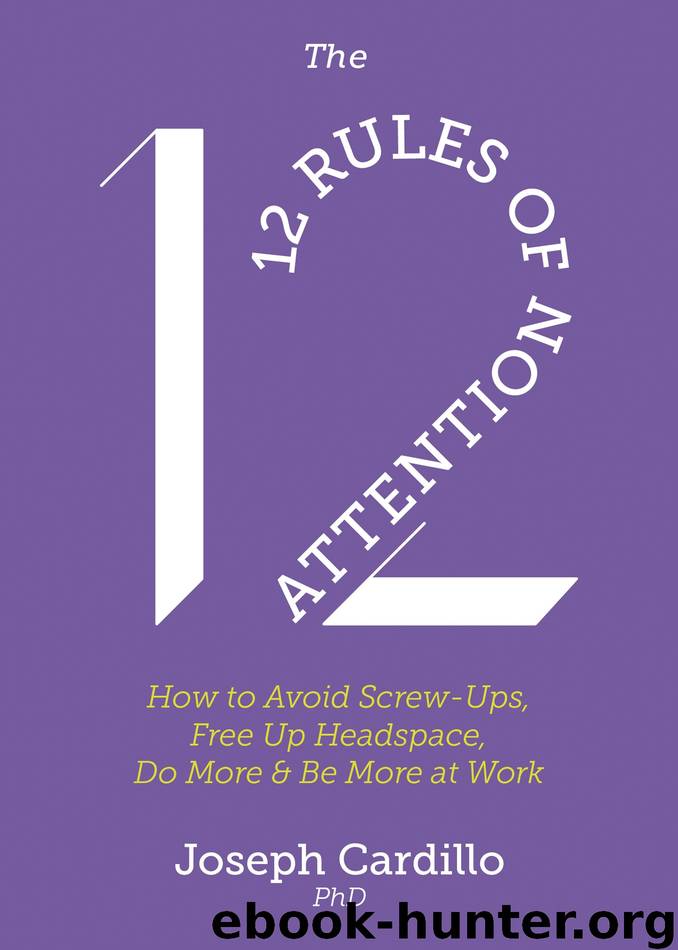The 12 Rules of Attention by Joseph Cardillo

Author:Joseph Cardillo
Language: eng
Format: epub
Publisher: Quercus
Published: 2020-07-16T16:00:00+00:00
You brain’s gisting capability allows you to take in a lot of sensory information in just fractions of a second. Use this information to scan your internal and external zones regularly and to keep them in balance with your goals.
CHAPTER EXERCISES
Scanning for Imbalance
Sometimes a glance may be all you need to get back into a flowing mind. If you are having difficulty staying in the flow of a task, take a fast glimpse at what is affecting you externally and internally.
1.Ask yourself, “What appears relevant and should be addressed? What is irrelevant?
2.Has your assessment of relevancy or irrelevancy suddenly come about? Why?
3.Do you want to change anything in how you are approaching your task?” Give it all a second look and focus on identifying any distracters interrupting your flowing mind-set. Consider when these should be addressed and then how you will do so.
Later, use reflection to adjust and learn how you might do things differently next time to avoid these distracters. This will imbed techniques and actions and link them to future endeavors so that you will automatically avoid similar problems.
Speaking in Public and Using PowerPoints
Musicians, actors, and professional public speakers rely on being able to determine how engaged their audience is, whether the audience is grasping the important parts of the presentation, and what the audience is most responding to. With some practice, you can make these determinations too. When giving your next talk, try to notice in a glance if individuals are engaged. You can also see what details they engage with most.
If you are in a larger room that requires a podium, try moving about the room, at least up to the first row of seating. You might even feel comfortable walking to the back or side of the room for a short moment. Try to make eye contact with sections of audience. It only takes a glance. If you notice someone positively connecting, you can even talk directly to that person when a detail applies directly to him or her.
You can also be more conversational if you utilize imagery in your PowerPoint and lessen text. This way, a quick glance at the imagery on screen is all you’ll need to compose your narrative. As we’ve discussed, the best images are those that are within your audience’s experiences as well as within yours. The best eye contact is the kind you make when you’re having a meal with a close friend and talking about a mutually meaningful idea.8
I always recommend using reflection after a presentation. This helps you see where things worked and where they didn’t so you can adjust for next time.
Download
This site does not store any files on its server. We only index and link to content provided by other sites. Please contact the content providers to delete copyright contents if any and email us, we'll remove relevant links or contents immediately.
Rewire Your Anxious Brain by Catherine M. Pittman(17589)
Talking to Strangers by Malcolm Gladwell(11876)
The Art of Thinking Clearly by Rolf Dobelli(8841)
Mindhunter: Inside the FBI's Elite Serial Crime Unit by John E. Douglas & Mark Olshaker(7834)
Becoming Supernatural by Dr. Joe Dispenza(7105)
Change Your Questions, Change Your Life by Marilee Adams(6641)
Nudge - Improving Decisions about Health, Wealth, and Happiness by Thaler Sunstein(6633)
The Road Less Traveled by M. Scott Peck(6633)
The Lost Art of Listening by Michael P. Nichols(6472)
Enlightenment Now: The Case for Reason, Science, Humanism, and Progress by Steven Pinker(6405)
Win Bigly by Scott Adams(6311)
Mastermind: How to Think Like Sherlock Holmes by Maria Konnikova(6235)
The Way of Zen by Alan W. Watts(5798)
Daring Greatly by Brene Brown(5639)
Grit by Angela Duckworth(4735)
Big Magic: Creative Living Beyond Fear by Elizabeth Gilbert(4723)
Men In Love by Nancy Friday(4320)
Flow by Mihaly Csikszentmihalyi(4052)
The Four Tendencies by Gretchen Rubin(4024)
